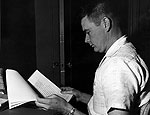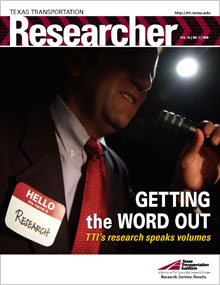The National Highway-Rail Grade Crossing Safety Training Conference

When the unstoppable force of a train meets the very moveable object of an automobile, the obvious dangers associated with highway-rail grade crossings can be deadly. In 2007, 338 people were killed and another 1,014 injured at these crossings in the United States.
A wide variety of stakeholders from the public sector, including state and federal transportation agencies, and the private sector, such as railroad companies, industry researchers, consultants and suppliers, have a common interest in improving safety at the more than 250,000 highway-rail grade crossings in the United States. Together they’ve helped decrease incidents at grade crossings in the last decade by 28 percent. But there’s work left to do. Bringing together these stakeholders is the aim of the biennial National Highway-Rail Grade Crossing Safety Training Conference, hosted by the Texas Transportation Institute’s (TTI’s) Rail Research Program.
“The conference brings participants up to date on the latest technologies and improvements to crossing safety from a technical and research point of view,” says Ron Ries, the staff director of the Highway-Rail Crossing and Trespass Division of the Federal Railroad Administration. “It’s an excellent forum to get people together from across the country to share ideas. There are regional conferences, but this is one of the few national conferences where this can happen.”
The 2007 conference, held in San Antonio, featured the theme “The Legacy Continues” and was dedicated to the late Hoy A. Richards, former TTI senior research scientist and leader in the highway-rail grade crossing area for more than 40 years. His enthusiasm and persistence for promoting safety at highway-rail grade crossings were instrumental in the formation of the Railroad Highway Grade Crossing Committee at the Transportation Research Board and the ITS User Service 30 for Highway-Railroad Intersections.
“Hoy Richards was a true pioneer in highway-rail grade crossing safety,” says Steve Roop, TTI assistant agency director in the Multimodal Freight Transportation Program. “The success in improving safety at these hazardous intersections is due in great measure to his efforts.”
Richards’ legacy also includes the Rail Safety Conference. He founded the conference in 1969 to get stakeholders together to improve rail safety. “The conference is an opportunity for group discussions in a roundtable format,” says Darin Kosmak, the railroad section director with the Traffic Operations Division of the Texas Department of Transportation. “The last conference wasn’t just made up of presenters. The roundtables allowed more interaction, which worked well. The last roundtable gave a summary of all the session presentations.”
Dave Peterson, senior manager of industry and public projects for Union Pacific Railroad, has attended the conference continuously since the early 1990s. “It’s an excellent source for disseminating information on changes in the rail safety arena on a national basis,” says Peterson. “What works on one side of the country might work on the other side. The conference helps share successes and failures, and raises the level of awareness of rail safety issues.”
